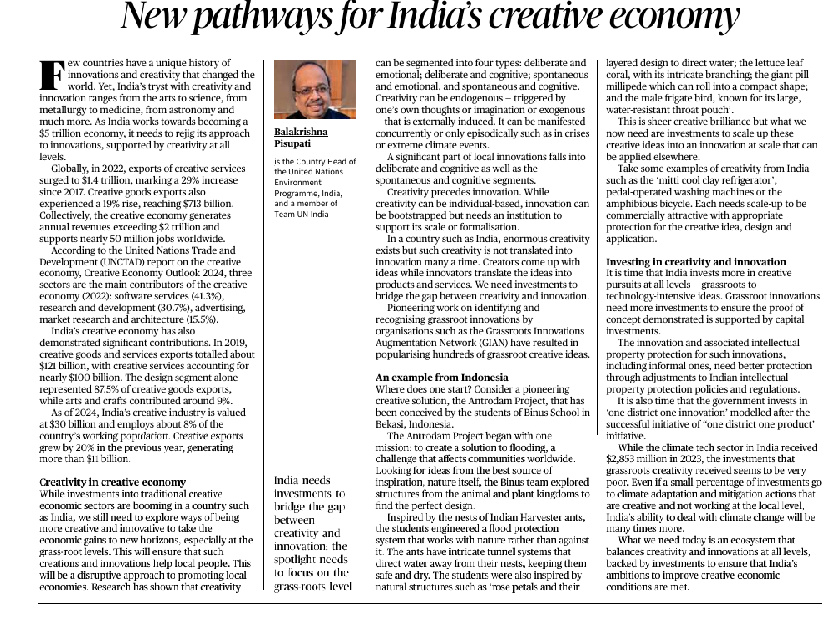🔶 1. Introduction: India’s Rich Creative Heritage
- India has a long tradition of creativity and innovation across disciplines: science, metallurgy, medicine, astronomy, etc.
- To transition into a $5 trillion economy, India must reimagine innovation strategies, with creativity at all levels.
🔶 2. Global Context of Creative Economy
- 2022 exports of global creative services: $1.4 trillion (29% increase since 2017).
- Creative goods exports: $1.3 trillion, up 19%.
- Globally, creative economy:
- Generates $2 trillion+ annually.
- Supports 50 million+ jobs.
- Generates $2 trillion+ annually.
🔶 3. India’s Creative Economy Landscape
- As per UNCTAD’s Creative Economy Outlook 2024, India’s creative economy (2020 data):
- Software services: 41.3%
- R&D: 30.7%
- Advertising, market research, architecture: 15.6%
- Software services: 41.3%
- 2019 creative goods exports: $121 billion.
- Creative services: ~$100 billion.
- Design segment: 57.5%
- Arts and crafts: ~9%
- Creative services: ~$100 billion.
- 2024 estimate:
- Industry size: $330 billion
- Employment: 8% of the workforce
- Creative exports rose 20% in the last year; value $1 billion+.
- Industry size: $330 billion
🔶 4. Understanding Creativity and Innovation
- Creativity ≠ Innovation: Creativity is idea generation; innovation is commercialization or application.
- Creativity forms:
- Deliberate-cognitive
- Deliberate-emotional
- Spontaneous-cognitive
- Spontaneous-emotional
- Deliberate-cognitive
- Innovation = Ideas + Resources + Scale-up mechanism.
🔶 5. Need for Grassroots Creativity
- Grassroots innovations = Cost-effective, local-use, low-tech, scalable.
- Often underrepresented in India’s innovation ecosystem.
- Need for investment, policy support, and institutional recognition.
🔶 6. Example from Indonesia – Rumah Resiliensi Project
- Focus: Flood mitigation and disaster resilience.
- Methods:
- Rainwater harvesting
- Community-led house reconstruction
- Using local solutions and climate adaptation
- Rainwater harvesting
- The approach transformed vulnerable urban areas using grassroots knowledge.
🔶 7. Indian Grassroots Innovations
- Examples:
- Clay refrigerator
- Pedal-powered machines
- Amphibious bicycle
- Clay refrigerator
- Many ideas stay unscaled due to lack of protection, investment, and policy support.
🔶 8. Challenges in Scaling Up
- Absence of:
- Financial and policy backing.
- Intellectual Property Rights (IPR)
- Institutional mechanisms for market access and design support.
- Financial and policy backing.
🔶 9. Policy Recommendations
- Better IPR frameworks for informal/grassroots innovations.
- Replication of successful models (e.g., “one district, one innovation”).
- Increased investment for climate resilience and local creativity.
- g., India spent $2.835 billion on climate tech in 2023.
- But grassroots innovations still lack funding.
- g., India spent $2.835 billion on climate tech in 2023.
🔶 10. Conclusion: India’s Path Forward
- India needs:
- Inclusive innovation ecosystem
- Blend of top-down investment with bottom-up creativity
- Better market linkages and protection frameworks
- Inclusive innovation ecosystem
This ensures that creative economic ambitions are realized sustainably.
GS Paper III – Economy / Science & Technology / Environment
10-Marker Questions (150 words)
“India’s journey towards a $5 trillion economy requires embedding creativity and innovation at all levels.” Examine the role of the creative economy in achieving this goal.


